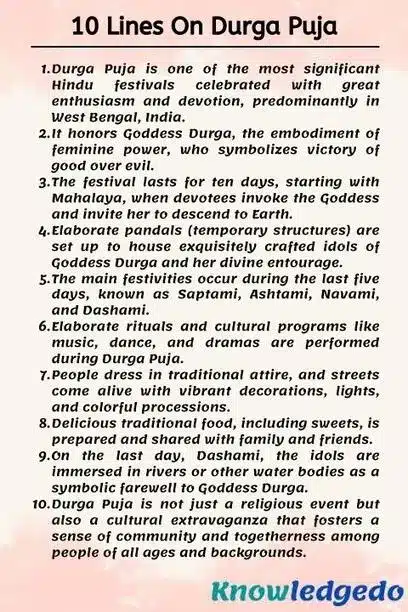Today, we are sharing 10 lines on Durga Puja in English. This article can help students who are looking for information about 10 lines on Durga Puja. This Lines is very simple and easy to remember. The level of these Lines is moderate so any student can write on this topic.
This article is generally useful for class 1,class 2,class 3,class 4,class 5,class 6,class 7,class 8,class 9,class 10,class 11,class 12
10 lines on Durga Puja
1) Durga Puja is one of the most significant Hindu festivals celebrated with great enthusiasm and devotion, predominantly in West Bengal, India.
2) It honours Goddess Durga, the embodiment of feminine power, who symbolizes the victory of good over evil.
3) The festival lasts for ten days, starting with Mahalaya, when devotees invoke the Goddess and invite her to descend to Earth.
4) Elaborate pandals (temporary structures) are set up to house exquisitely crafted idols of Goddess Durga and her divine entourage.
5) The main festivities occur during the last five days, known as Saptami, Ashtami, Navami, and Dashami.
6) Elaborate rituals and cultural programs like music, dance, and dramas are performed during Durga Puja.
7) People dress in traditional attire, and the streets come alive with vibrant decorations, lights, and colourful processions.
8) Delicious traditional food, including sweets, is prepared and shared with family and friends.
9) On the last day, Dashami, the idols are immersed in rivers or other water bodies as a symbolic farewell to Goddess Durga.
10) Durga Puja is not just a religious event but also a cultural extravaganza that fosters a sense of community and togetherness among people of all ages and backgrounds.

5 lines on Durga Puja
1) Durga Puja is an important Hindu festival dedicated to Goddess Durga, celebrated with enthusiasm in various parts of India, especially in West Bengal.
2) The festival usually spans over five days, during which beautifully adorned pandals house idols of Goddess Durga and her divine entourage.
3) Devotees perform rituals, offer prayers, and seek blessings for prosperity and protection from evil forces during Durga Puja.
4) Streets and homes are adorned with colourful decorations, lights, and festive cheer, creating a vibrant and joyous atmosphere.
5) The immersion of the idols in water bodies on the last day marks the conclusion of the festival, signifying the departure of Goddess Durga back to her heavenly abode.
FAQ
Answer: Durga Puja is a Hindu festival dedicated to Goddess Durga, who represents the triumph of good over evil. It is celebrated to honour the divine power of the goddess and seek her blessings for prosperity, protection, and well-being.
Answer: Durga Puja usually takes place in the months of September or October, according to the Hindu lunar calendar. The festival spans five days, with the main celebrations occurring during the last four days – Saptami, Ashtami, Navami, and Dashami.
Answer: Durga Puja is prominently celebrated in the Indian state of West Bengal, particularly in the capital city of Kolkata. However, it is also observed with fervour in other parts of India, such as Assam, Odisha, Bihar, and Tripura.
Answer: The rituals of Durga Puja include elaborate prayers, offerings of flowers and fruits to the goddess, the recitation of holy verses, and the performance of traditional dances and cultural programs. Additionally, devotees visit pandals to see the beautifully crafted idols of Goddess Durga and participate in the grand processions.
Answer: The last day of Durga Puja is known as Dashami or Vijayadashami. On this day, the idols of Goddess Durga, along with her divine entourage, are taken in colourful processions through the streets. These idols are later immersed in rivers or other water bodies as a symbolic farewell, signifying the return of the goddess to her celestial abode.
